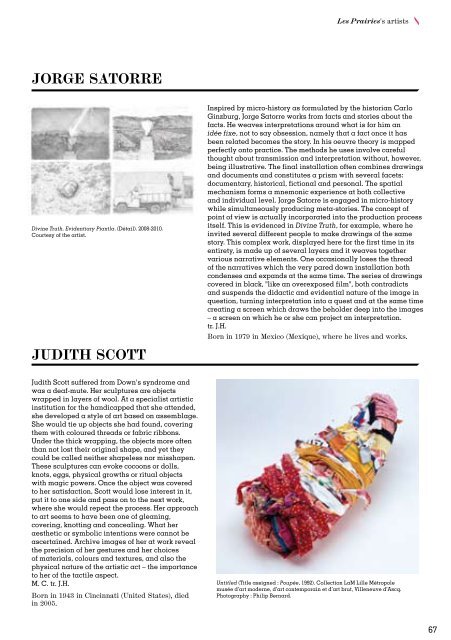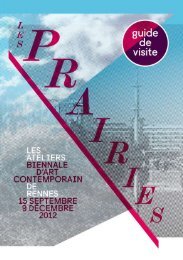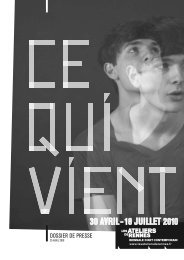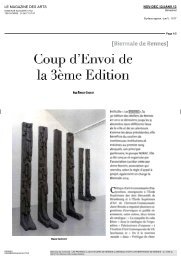Download here the Visitor's guide. - Les Ateliers de Rennes
Download here the Visitor's guide. - Les Ateliers de Rennes
Download here the Visitor's guide. - Les Ateliers de Rennes
You also want an ePaper? Increase the reach of your titles
YUMPU automatically turns print PDFs into web optimized ePapers that Google loves.
JORGE SATORRE<br />
Divine Truth. Evi<strong>de</strong>ntiary Piaxtla. (Détail). 2008-2010.<br />
Courtesy of <strong>the</strong> artist.<br />
JUDITH SCOTT<br />
Judith Scott suffered from Down's syndrome and<br />
was a <strong>de</strong>af-mute. Her sculptures are objects<br />
wrapped in layers of wool. At a specialist artistic<br />
institution for <strong>the</strong> handicapped that she atten<strong>de</strong>d,<br />
she <strong>de</strong>veloped a style of art based on assemblage.<br />
She would tie up objects she had found, covering<br />
<strong>the</strong>m with coloured threads or fabric ribbons.<br />
Un<strong>de</strong>r <strong>the</strong> thick wrapping, <strong>the</strong> objects more often<br />
than not lost <strong>the</strong>ir original shape, and yet <strong>the</strong>y<br />
could be called nei<strong>the</strong>r shapeless nor misshapen.<br />
These sculptures can evoke cocoons or dolls,<br />
knots, eggs, physical growths or ritual objects<br />
with magic powers. Once <strong>the</strong> object was covered<br />
to her satisfaction, Scott would lose interest in it,<br />
put it to one si<strong>de</strong> and pass on to <strong>the</strong> next work,<br />
w<strong>here</strong> she would repeat <strong>the</strong> process. Her approach<br />
to art seems to have been one of gleaning,<br />
covering, knotting and concealing. What her<br />
aes<strong>the</strong>tic or symbolic intentions were cannot be<br />
ascertained. Archive images of her at work reveal<br />
<strong>the</strong> precision of her gestures and her choices<br />
of materials, colours and textures, and also <strong>the</strong><br />
physical nature of <strong>the</strong> artistic act – <strong>the</strong> importance<br />
to her of <strong>the</strong> tactile aspect.<br />
M. C. tr. J.H.<br />
Born in 1943 in Cincinnati (United States), died<br />
in 2005.<br />
<strong>Les</strong> Prairies's artists<br />
Inspired by micro-history as formulated by <strong>the</strong> historian Carlo<br />
Ginzburg, Jorge Satorre works from facts and stories about <strong>the</strong><br />
facts. He weaves interpretations around what is for him an<br />
idée fixe, not to say obsession, namely that a fact once it has<br />
been related becomes <strong>the</strong> story. In his oeuvre <strong>the</strong>ory is mapped<br />
perfectly onto practice. The methods he uses involve careful<br />
thought about transmission and interpretation without, however,<br />
being illustrative. The final installation often combines drawings<br />
and documents and constitutes a prism with several facets:<br />
documentary, historical, fictional and personal. The spatial<br />
mechanism forms a mnemonic experience at both collective<br />
and individual level. Jorge Satorre is engaged in micro-history<br />
while simultaneously producing meta-stories. The concept of<br />
point of view is actually incorporated into <strong>the</strong> production process<br />
itself. This is evi<strong>de</strong>nced in Divine Truth, for example, w<strong>here</strong> he<br />
invited several different people to make drawings of <strong>the</strong> same<br />
story. This complex work, displayed <strong>here</strong> for <strong>the</strong> first time in its<br />
entirety, is ma<strong>de</strong> up of several layers and it weaves toge<strong>the</strong>r<br />
various narrative elements. One occasionally loses <strong>the</strong> thread<br />
of <strong>the</strong> narratives which <strong>the</strong> very pared down installation both<br />
con<strong>de</strong>nses and expands at <strong>the</strong> same time. The series of drawings<br />
covered in black, "like an overexposed film", both contradicts<br />
and suspends <strong>the</strong> didactic and evi<strong>de</strong>ntial nature of <strong>the</strong> image in<br />
question, turning interpretation into a quest and at <strong>the</strong> same time<br />
creating a screen which draws <strong>the</strong> behol<strong>de</strong>r <strong>de</strong>ep into <strong>the</strong> images<br />
– a screen on which he or she can project an interpretation.<br />
tr. J.H.<br />
Born in 1979 in Mexico (Mexique), w<strong>here</strong> he lives and works.<br />
Untitled (Title assigned : Poupée, 1992). Collection LaM Lille Métropole<br />
musée d’art mo<strong>de</strong>rne, d’art contemporain et d’art brut, Villeneuve d’Ascq.<br />
Photography : Philip Bernard.<br />
67






